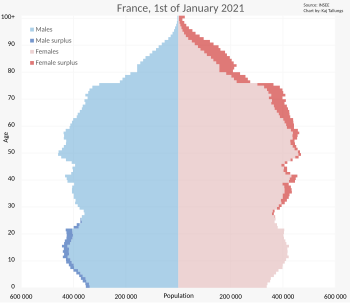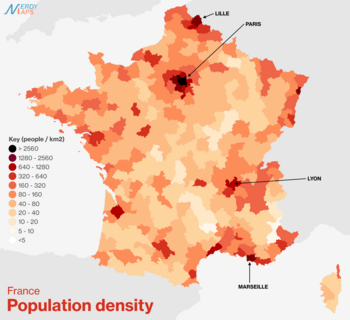| Demographics of France | |
|---|---|
 Population pyramid, 2021 | |
| Population | |
| Birth rate | |
| Death rate | |
| Life expectancy | |
| • male | |
| • female | |
| Fertility rate | |
| Infant mortality rate | |
| Net migration rate | |
| Age structure | |
| 0–14 years | |
| 15–64 years | |
| 65 and over | |
| Nationality | |
| Nationality | French |
| Major ethnic | French (Native) |
| Minor ethnic |
|
| Language | |
| Official | French (official) |
| Spoken | Languages of France |



The demography of France is monitored by the Institut national d'études démographiques (INED) and the Institut national de la statistique et des études économiques (INSEE). As of 1 January 2021, 66,142,961 people lived in Metropolitan France, while 2,230,472 lived in overseas France, for a total of 68,373,433 inhabitants in the French Republic.[5]
In March 2017, the population of France officially reached the 67,000,000 mark. It had reached 66,000,000 in early 2014.[6] Between the years 2010–17, the population of France grew from 64,613,000 to 66,991,000 (i.e. about 2.4 million people in a span of 7 years), making France one of the fastest-growing countries in Europe. The population of France is growing by 1,000,000 people every three years- an average annual increase of 340,000 people, or +0.6%.[7]
France was historically Europe's most populous country. During the Middle Ages, more than one-quarter of Europe's total population was French;[8] by the seventeenth century, this had decreased slightly to one-fifth. By the beginning of the nineteenth century, other European countries, such as Germany and Russia, had caught up with France and overtaken it in number of people. However, the country's population sharply increased with the baby boom following World War II. According to INSEE, since 2004, 200,000 immigrants entered the country annually. One out of two was born in Europe and one in three in Africa. Between 2009 and 2012, the number of Europeans migrating to France increased sharply (plus 12% per year on average), but the percentage would steadily decrease by 2022, supplanted by a rise in the number of immigrants from Africa.[9][10][11]
The national birth rate, after dropping for a time, began to rebound in the 1990s and currently the country's fertility rate is close to the replacement level. According to a 2006 INSEE study, "the natural increase is close to 300,000 people, a level that has not been reached in more than thirty years."[12] With a total fertility rate of 1.83 in 2020,[13] France however remains the most fertile country in the European Union.[14][15]
Among the 802,000 babies born in metropolitan France in 2010, 80.1% had two French parents, 13.3% had one French parent, and 6.6% had two non-French parents.[16][17][18]
Between 2006 and 2008, about 22% of newborns in France had at least one foreign-born grandparent (9% born in another European country, 8% born in the Maghreb and 2% born in another region of the world).[19] Censuses on race and ethnic origin were banned by the French government in 1978.[20]
In 2021, the Total Fertility Rate of France was 1.82, and 7.7% was the percent of births to women that were their 4th+ child.
- ^ "Titre | Insee". www.insee.fr.
- ^ a b "Bilan démographique 2021". Insee. Retrieved 19 January 2021.
- ^ "Demographic report 2023 - Insee Première - 1978".
- ^ "Espérance de vie à divers âges et taux de mortalité infantile, France" (in French). INSEE. Retrieved 5 May 2020.
- ^ Population of Metropolitan France: [1]. The population of all five overseas departments totaled 2,172,000 [2] in January 2021. The population of the overseas collectivities amounted to 613,000 inhabitants (Saint-Pierre and Miquelon [3], Saint-Barthélemy [4], Saint-Martin [5], French Polynesia [6], Wallis et Futuna [7], New Caledonia [8]). The total population of the overseas departments and territories of France is estimated at 2,785,000.
- ^ "Titre - Insee". Bdm.insee.fr. Archived from the original on 12 June 2017. Retrieved 1 September 2017.
- ^ "Bilan démographique 2016 - Insee Première - 1630". Insee.fr. Retrieved 1 September 2017.
- ^ Population Growth and Agrarian Change: An Historical Perspective pp. 64-66.
- ^ "Qui sont les nouveaux immigrés qui vivent en France ?". SudOuest.fr. 12 February 2014.
- ^ "L'essentiel sur... les immigrés et les étrangers | Insee". www.insee.fr. Retrieved 13 July 2023.
- ^ "Immigration rose in France in 2022, driven by labor needs and foreign students". Le Monde.fr. 27 January 2023. Retrieved 13 July 2023.
- ^ "Insee − Institut national de la statistique et des études économiques". Insee.fr. Retrieved 1 September 2017.
- ^ "Indicateur conjoncturel de fécondité en 2020". INSEE. Retrieved 28 August 2021.
- ^ "Demography report 2020". INSEE. Retrieved 19 January 2021.
- ^ "File:Total fertility rate, 1960–2015 (live births per woman) YB17.png - Statistics Explained". ec.europa.eu.
- ^ "Résultats de la recherche - Insee". Insee.fr. Retrieved 1 September 2017.
- ^ Having two foreign-born parents does not mean that the granting of French citizenship is an automatic birthright.
- ^ "Insee − Institut national de la statistique et des études économiques - Insee". Insee.fr. Retrieved 1 September 2017.
- ^ Les immigrés, les descendants d'immigrés et leurs enfants, Pascale Breuil-Genier, Catherine Borrel, Bertrand Lhommeau; Insee.fr, 2011
- ^ "French plan to break taboo on ethnic data causes uproar". the Guardian. 23 March 2009. Retrieved 21 November 2022.
The 1978 law that bans collecting ethnic data has roots in France's shame over collaboration with the Nazis during the second world war, when Jews were marked with yellow stars and sent to death camps.